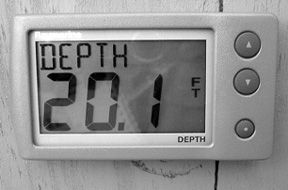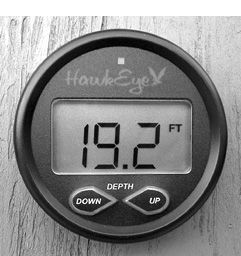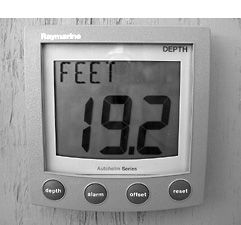Last December we reviewed fishfinders (aka scanning sounders) in Practical Sailor. If you’re installing a depthsounder (and through-hull transducer) for the first time, and have space for such an instrument, it makes sense to at least consider a sounder that will paint you a picture of the bottom as well as give you depth numbers and (usually) water temperature—especially because monochrome fishfinders are priced about the same as single-purpose sounders, or even less. (If you’re a fisherman as well as a sailor, so much the better.) In a future issue we’ll review color fishfinders, too.

However, there are also plenty of reasons to choose a numbers-only sounder. They take up little space; they can be, and usually are, members of instrument systems from the same manufacturer (see the story on integrated instrument systems in the July 1 issue); and they admirably fill the holes in bulkheads left by sounders that eventually give up the ghost after years of service.
What We Tested
We tested nine digital display depth sounders from six different manufacturers in two categories: those with large displays and those with small displays, and two different ranges, which could simply be called “more expensive” and “less expensive.” This was not a comprehensive test of all the stand-alone depthsounders on the market. We focused on samplings from those ranges. Our thinking is that if you’re simply going to plug an old hole with a new sounder, one of the less expensive ones, provided it works decently, might be attractive for the price. On the other hand, there are features and capabilities in some of the more sophisticated sounders that may be worth the added expense. Obviously, if your instrument system consists of several displays from one manufacturer, it will make sense to consider adding or replacing an instrument that fits technically and visually with what’s already there.
We looked at four “small” sounders, which have round bezels and will fit a standard 2-1/8″ instrument hole: the Lowrance 3500, the Teleflex TFX IDD, the Norcross Hawkeye and the Uniden QT206. Ranging in price from $89 to $149, these four units are far less expensive than the other five large units that range from $179 to $399. From Raymarine we got the ST40 and ST60 displays, and from Standard Horizon the DS35, DS45 and DS150.
Each unit was tested with its transom-mounted transducer, which was mounted to a board that was submerged alongside our test boat. (All these instruments are also available with through-hull transducers, which would of course be the proper one to use on a sailboat.) We were very careful to keep the transducer board fully submerged, level, and out of turbulent water at all times.
How We Tested
Our test began by flush-mounting each unit onto a simulated bulkhead or instrument panel (a sheet of plywood) temporarily fixed to the test boat. (Optional mounting brackets are either supplied by or available from the manufacturers for situations where flush mounting is not an option.) The panel was capable of holding all units side by side for easy viewability evaluations.
Each unit was rated for ease of installation for the display unit only. We did not rate the installation of each transducer or individual unit wiring to a power source, as this would be nearly identical for each unit.
We gave each sounder a rating for how easy the display was to see during the day, as well as at night. We also gave each unit an on-the-water performance rating. A unit earned good ratings if it displayed a steady, reliable reading. If it read erratically or its screen went blank for no reason, it was downrated.
To confirm depth claims made by manufacturers, we took all units to shallow water to get a minimum depth reading. Then we headed deep, and tested the units at various depths (to a maximum of 400 feet) to find each unit’s maximum depth reading. Back at the dock, we compared our numbers to the manufacturers’ claimed maximum depth capabilities.
Lowrance 3500
The Lowrance is one of the four small round units sized to fit into a standard 2-1/8″ instrument panel cutout. Installation required cutting a hole in our test panel using a power drill with a proper size hole saw in the chuck. The unit is then pushed in from the front, and two “wings” are deployed from the rear to lock into the panel. Tightening is accomplished with front-mounted screws. The alarm horn is a separate unit that must be mounted and wired. This additional step is what generated the “fair” installation rating for this unit.
Like all of the small units, the 3500 has a rectangular display in the center of its round bezel that shows the digital depth reading. The Lowrance and the Teleflex have the smallest display numbers: only 7/16″ high.
The 3500 read to a minimum depth of 3 feet and a maximum of just over 100 feet. Lowrance makes no depth range claims for this unit.
This unit scored a “fair” in our water tests due to its erratic readings. As an example, while sitting still with the transducer in 15 feet of water, the unit’s reading constantly changed from 13 to 17 feet.
The unit will read in feet or meters, has a 1-year warranty, and a white backlight that can be turned on or off, but it requires a user-installed switch to do so.
Bottom Line: We think there are better choices than this sounder, which is priced at least 50% more than comparable units and displayed sometimes erratic readings.

Norcross Hawkeye
Installation of the Norcross Marine Hawkeye, model DF1000D, is similar to the Lowrance 3500, but requires the transducer cables to be crimp-connected. If you don’t have a crimping tool, this can be a real pain. (See the August 15 story on stripping and crimping tools.)
Display numbers on the Hawkeye are 9/16″ high and easy to see, day or night. A green backlight is on at all times. During on-the-water testing, the unit gave steady, accurate readings with a minimum depth reading of 2.7 feet and a maximum of 130 feet. Norcross claims a depth capability of 2 to 200 feet. It reads in feet or meters and has a 2-year warranty.
Bottom Line: A good choice. Inexpensive and accurate.
Ray ST40
Raymarine’s ST40 has a display head measuring 5″ wide by 2-3/4″ high, with the actual screen taking up the bulk of this space. Installation requires a single 2-1/4″ hole. This cutout must be precise, as the mounting bracket allows little room for error. Its large, 1-1/16″-high numbers are easy to read. The display is rated excellent for both day and night viewing; it is easily read even at extreme angles with polarized sunglasses. The green backlight is bright and has three levels of adjustment for both brightness and contrast.
Although Raymarine claims the ST40 will read from 0 to 400 feet, we were only able to get a reading of 3.5 feet on the shallow end, however it did read to 400 feet.
The unit gave steady, reliable readings during testing. Features include a trend indicator (which appears when the depth consistently rises or falls), display dampening (adjusts the repeat rate of the depth reading displayed), keel offset, and a 2-year warranty.
The ST40 can display depth in feet, meters, or fathoms. Communication with other instruments is accomplished via Raymarine’s proprietary Seatalk or the standard NMEA 0183 protocol. Either will require the purchase of additional cabling or a junction box.
Accessing all the features of the ST40 does require reference to the owner’s handbook. A very useful quick reference card is provided, however.
Bottom line: The unit has nearly all the features of the ST60, for $150 less. We like its easy-to-read screen. Our top pick.
Ray ST60
The ST60 uses a square portion of panel space measuring approximately 4-1/2″. Installation requires a 3-1/2″ hole, plus two smaller holes for mounting screws. It has all the features of the smaller ST40, plus a couple extras, like backlit buttons. Screen quality and performance are equal to or slightly better than the ST40. We did have some trouble programming the ST60’s shallow alarm even though we followed the procedures outlined in the manual. However, after several tries, we were able to get it to work. This unit is the most complicated to use of all tested. Raymarine claims the ST60 will read up to 400 feet deep and it did so during testing.
Bottom Line: It’s a great unit, but we don’t think its features and capabilities will justify the higher cost for most people.
Standard DS35
Measuring 2″ high and 5″ wide, the DS35 is the smallest unit from Standard that we tested. Installation requires a square cutout and the use of a rather complex bracket system.
Numbers on its display measure 3/4″ high and were easy to see in daylight. But, viewed through polarized sunglasses, the screen blanked while viewing at angles greater than 45 degrees.
Its white backlighting has three levels of adjustment, but even on the “high” setting it is not bright enough for good night viewing.
The DS35 does give steady, accurate depth readings to a minimum of 3 feet and a maximum of 300 feet. Features include a trend arrow, display dampening, keel offset, and a 1-year warranty. Available units of measure are feet, meters, or fathoms.
Bottom Line: Although the DS35 is the least expensive of the large displays, it lacks NMEA support and has weak backlighting.
Standard DS45
The DS45 is a large round instrument measuring 5″ in diameter. The actual screen is about 1″ by 3″, and display numbers are 3/4″ high.
We were easily able to make the 4″ round cutout needed to install the unit with a power saber saw. The DS35 comments on day viewing, night viewing, backlighting, performance, and features all apply to the DS45. The exceptions: The DS45 backlight is red rather than white, and it read to a maximum depth of 400 feet.
Bottom Line: This sounder head was designed as a replacement for instruments that fit a 4″ bulkhead hole (Datamarine in particular). It has been on the market a long time, and has proven itself. Today, however, the ratio of displayed information to panel space used is unbalanced. If you have an old 4″ hole to fill, this instrument will fill it capably enough, but at a premium price.
Standard DS150
At 4-1/2″, the display head on the DS150 is about the same size as the big Raymarine ST60. However, the actual screen size is smaller, as are the display numbers (the height is 1-1/4″). Installation on the DS150 is simple: drill a single 1-1/4″ hole and tighten one plastic nut to hold the display tight. Again, DS35 comments on day viewing, night viewing, and features all apply to the DS150.

Unlike the two other Standard units, the DS150 can communicate via the standard NMEA protocol. This unit has no backlighting increments—just on or off. Like the other two, it needs to be brighter.
Maximum depth capability was only 200 feet, and it seemed to take a long time to lock onto the bottom.
One programming issue on the DS150 is that it only takes one push of a button (the arrow key) to change from feet to fathoms or meters. On all other units tested, you have to push a button twice. It’s hard to say whether this is a convenience or an invitation to an accidental switch.
Bottom Line: Installation is very simple, but viewability could be better in several conditions. It was slow to lock onto the bottom.
Teleflex TFX IDD
The Teleflex TFX IDD, one of the four in the small category, is also marketed by Humminbird as the HDR 600. They are identical. Installation is similar to other small units, requiring a 2-1/8″ cutout and mounting a separate horn. The unit is held fast with a single bolt bracket.
The display numbers match the smallest tested at a height of 7/16″. Viewed through polarized sunglasses, the display of the TFX was somewhat less readable, even straight on. Without the glasses it’s clear. Night viewing is good with an always-on red backlight. Teleflex makes a depth capability claim of 0 to 600 feet. We only tested to 400 feet, and the Teleflex read to that depth. The minimum depth reading we obtained was 2.5 feet.
Performance of this unit is not as strong as most others. The display jumps around even when the boat remains relatively still. The TFX will read in feet, meters, or fathoms and has a 1-year warranty.
Bottom Line: We’d steer clear of the TFX due to its relatively difficult-to-read display and sometimes-erratic readings.
Uniden QT206
The last of our small sounders is the QT206 from Uniden. Installation is standard, using a 2-1/8″ hole and single bolt metal bracket. Display numbers are equal to the Norcross Hawkeye at a height of 9/16″. Both day and night viewing were good. Performance on the water was steady and accurate. Uniden claims a depth capability of 2 to 199 feet. We were able to read 2.5 feet shallow and 190 feet deep. It only reads in feet, and carries a 1-year warranty.
Bottom Line: In the small category, it’s a toss up between this unit and the Hawkeye. The QT206 can be found for ten bucks less, and reads somewhat deeper, but carries a shorter warranty.
Conclusion
We found the overall performance of the two Raymarine units superior to the others tested. We selected the ST40 as the top pick because we don’t think the bigger ST60 has $150 worth of extra features.
Those looking for a less expensive unit simply to display depth should consider the Norcross Hawkeye or the Uniden QT206. They both do the job accurately.
A final observation: All these sounders have at least one type of depth alarm; we operated them on every unit. They did work as advertised, but in our opinion, they’re not loud enough to get your attention if it’s noisy on deck, or even if you’re a heavy sleeper.
Also With This Article
Click here to view “Value Guide: Stand-Alone Sounders.”
Click here to view “Sounders: Ratings.”
Click here to view “Noted, But Not Tested.”
Contacts
• Lowrance, 800/324-1356, www.lowrance.com
• Navman USA, 866/628-6261, www.navmanusa.com
• Norcross, 888/NORCROSS, www.norcrossmarine.com
• Raymarine, 800/539-5539, www.raymarine.com
• Signet Marine, 310/320-4349, www.signetmarine.com
• Simrad, 954/922-7700, www.simradusa.com
• Standard Horizon, 714/827-7600, www.standardhorizon.com
• Teleflex, 941/907-1000, www.teleflexmorse.com
• Uniden 800/297-1023, www.uniden.com
































